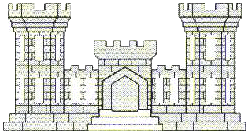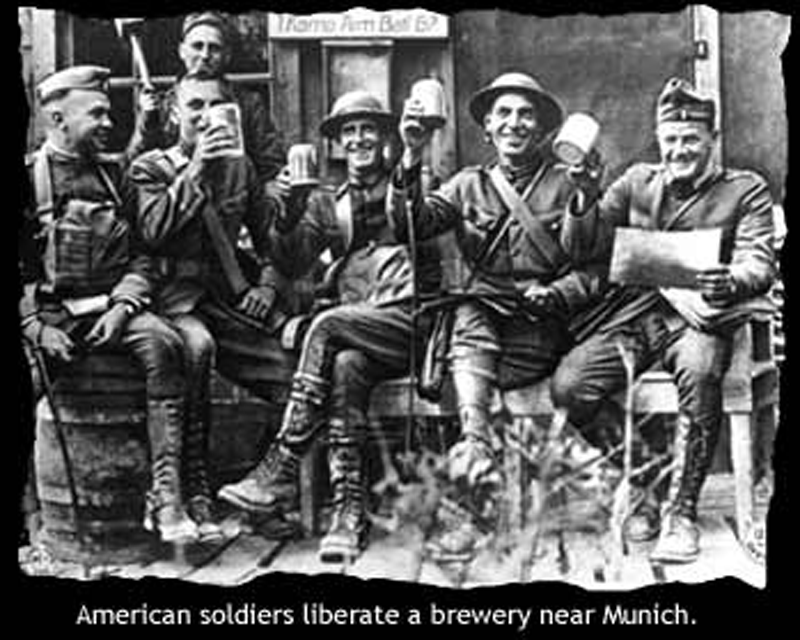 Corps
of Engineers
Corps
of EngineersClick here to go back
to 563rd Combat Engineer Battalion Stuttgart 1979-1982 locator site.
Rick Phillips, Ken Thompson aka "Fritz the Hat" Tom Black aka "Ted" Tim O'Brian "OB", Chris Carter
 Corps
of Engineers
Corps
of Engineers
Mission areas
The dependence on foreign trained military engineers in the Revolution led to the formal establishment of the Corps of Engineers and a Military Academy at West Point, New York in 1802. The Corps was responsible for running the U.S. Military Academy from its birth to the end of the Civil War. The Academy produced officers who were capable of applying their knowledge to military engineering as well as much needed nation building for the ever expanding United States.
With the enactment of the first River and Harbor Act in 1824, the Corps became the Federal Agency responsible for navigation and flood control on the nation's rivers. Participation by Army Engineers in mapping the west (Lewis and Clark were Army Engineers) and in developing rail and water transportation systems provided the infrastructure that allowed the country to grow from a weak agricultural society to the strongest industrial nation on earth. Engineers provided the expertise that enabled U.S. forces to be victorious in the Mexican War (Scott's Opinion). Military Engineers also ushered in modern warfare during the Civil War through such innovations as land mines, trench fortifications and the use of balloons for observation and mapping.
When the nation needed leaders to tackle hard problems, it invariably turned to Engineer officers. Colonel George Goethals directed construction of the Panama Canal in the early 1900's and Brigadier General Leslie Groves supervised the Manhattan Project that developed the atomic bomb.
In World War I, Army Engineers were the first U.S. soldiers sent to Europe. The 11th Engineer Regiment suffered the first U.S. casualties of the war while working to clear a passage through no-man's land in France. General Douglas MacArthur described World War II as an Engineer's War, with more engineers in the Pacific Theater than infantrymen. Engineers were first on the beach at Normandy to clear obstacles; captured the bridge a Remagen, built the 1,500 mile ALCAN highway through frozen tundra in Alaska; constructed the Ledo road through 438 miles of jungle to link Burma and India; erected camps and cantonments for 5.3 million troops, factories to produce ammunition and tanks, a huge network of ports, bomber bases, hospitals with 1/2 million beds, and even the Pentagon to consolidate the War Department's command and control of our armed forces.
The contributions of Army Engineers were no less important in Korea and Vietnam. In Korea, Engineer soldiers frequently found themselves trapped behind enemy lines and fighting as infantry. In Vietnam, Engineer soldiers rappelled into enemy controlled jungle areas to blast landing zones for infantry assaults.
In its peacetime role as Federal Engineer, the Corps continued to build for America's tomorrow. In the 1950's, it was instrumental the development of the St. Lawrence Seaway, the design and construction of ICBM launching sites, flood control dams and levies on the Mississippi and Ohio rivers. During the 1960's, the Corps helped build the Manned Space Center in Houston and the Kennedy Space Center in Florida. In the 1970's the Corps took on additional missions to develop hydroelectric power and new methods of flood control on the nation's rivers. Throughout the 1980's, the Corps managed construction of an entire military infrastructure for the Saudi Arabian government, built airbases in Israel and Egypt, constructed the Space Shuttle complex at Edwards Air Force Base, California and was the nation's agent for the Environmental Protection Agency's Superfund clean-up.
The basic TOE unit of the engineer system is the battalion. Although engineer battalions normally have a fixed organization, they may also be tailored for specific requirements. Battalions are employed when it is desirable to assign a unit with the complete control of a task or an area. There are four basic types of engineer battalions, plus a variety of different types of separate companies:
Combat Engineer Battalion (Corps) -- Corps combat engineer battalions are normally assigned to a corps' engineer brigade (i.e. V Corps in Europe contains the 130TH Engineer Brigade consisting of three engineer battalions and a number of separate companies). Most corps combat engineer battalions in Europe have been converted into tracked units (i.e. squads are transported in armored personnel carriers). Somewhat larger than the divisional engineer battalions, the corps combat engineer battalions provide combat and sustainment engineering support in the corps and division sectors. They may reinforce divisional engineer battalions and execute infantry combat missions when required.
Engineer Battalion (Combat Heavy) -- The combat heavy engineer battalion is normally assigned to an engineer brigade within a corps or theater army. The combat heavy engineer battalion has equipment and personnel skilled in earthmoving and construction. The battalion primarily works in rear areas on sustainment engineering tasks. However, its earthmoving capabilities may be effectively used to provide combat support in forward areas when not under direct fire (i.e. tank ditches, etc.). Missions include the construction of roads, airfields, structures and utilities for the Army and Air Force.
Engineer Topographic Battalion -- Engineer topographic battalions are assigned to the senior engineer headquarters of a theater army. These units provide topographic engineer and terrain analysis support to all units. It does not have the capability to accomplish infantry combat missions.
Separate Engineer Companies -- Separate engineer companies in the force structure are designed to provide additional specialized support in areas such as bridging, equipment support, port construction, pipeline construction, mapping and terrain analysis.
As a Bridge Platoon Leader in Korea, you'll be responsible for the care and maintenance of about 40 personnel and $5 million worth of ribbon bridging equipment. During the annual Team Spirit Exercise, your unit will develop a river crossing site for a ROK Armored Division. Under cover of darkness you construct a bridge on the Imjin River and cross 150 tanks, then break the bridge and recover the components before daylight.
As a Platoon Leader in a Combat Heavy Engineer Battalion you can expect missions to construct or renovate buildings and install electrical or plumbing systems using plans developed by your Battalion S-3 section. You'll be responsible for design review, construction estimation and development of the construction schedule using CPM or PERT. At the same time, you'll be leading 30+ soldiers with such diverse skills as carpenter, mason, plumber, electrician and heavy equipment operator. Your leadership will be challenged in maintaining about $5 million worth of government equipment. If stationed in CONUS you may deploy to Latin America to construct roads, airfields or buildings. ENGINEERS have been described as a STRATEGIC FORCE in our National Strategy for that region of the world. The Engineer platoon often is called upon to operate independently. Because of this fact, Engineer lieutenants often get greater responsibility and authority than lieutenants in other branches.
